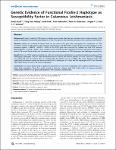Genetic Evidence of Functional Ficolin-2 Haplotype as Susceptibility Factor in Cutaneous Leishmaniasis
Assaf, Amal
Hoang, Tong Van
Faik, Imad
Aebischer, Toni
Kremsner, Peter G.
Kun, Jürgen F. J.
Velavan, T. P.
Background: Ficolin-2 coded by FCN2 gene is a soluble serum protein that plays an important role in innate immunity. In this study, we analyzed five functional polymorphisms of the FCN2 gene for their possible association with cutaneous leishmaniasis. Methods: Initially we screened 40 Syrian Arabs for the entire FCN2 gene. We investigated the contribution of FCN2 functional variants in 226 patients with cutaneous leishmaniasis and 286 healthy controls from Syria. Polymorphisms in the promoter regions (2986G/A, 2602G/A, 24A/G) of the FCN2 gene were assessed by TaqMan real time PCR, whereas polymorphisms in exon8 (+6359C/T and +6424G/T) were assessed by DNA sequencing. We also measured serum ficolin-2 levels in 70 control Syrian Arabs and correlated the serum concentrations to FCN2 genotypes and haplotypes respectively. Results: Nine new FCN2 variants including two with non synonymous substitutions in exon6 and exon8 were observed. The homozygous genotypes +6424T/T were distributed more in controls and none in patients (P = 0.04). The AGACG haplotype were observed more in patients than in controls (OR = 2.0, 95%CI 1.2–3.4, P = 0.006). The serum ficolin-2 levels were significantly distributed among the reconstructed ficolin-2 haplotypes (P,0.008) and the haplotype AGACG was observed with higher ficolin-2 levels in 70 control individuals. Conclusion: Our results demonstrate a significant association of FCN2 AGACG haplotype with cutaneous leishmaniasis in a Syrian Arab population. These first results provide a basis for a future study that could confirm or disprove possible relationships between FCN2 gene polymorphisms with cutaneous leishmaniasis.
Dateien zu dieser Publikation
Keine Lizenzangabe

